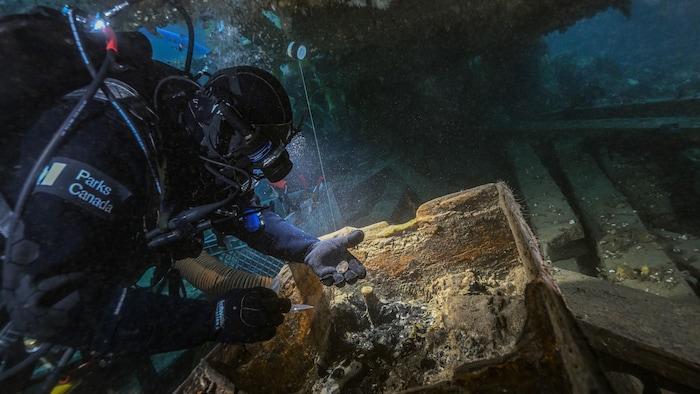Open in full screen mode Parks Canada underwater archaeologist Marc-André Bernier carefully searches a sailor's chest in the forecastle (crew quarters) on the lower deck of HMS Erebus, September 17, 2023.
Summer excavations on the wreck of the Erebus, one of two ships in John Franklin's expedition to successfully complete the first crossing of the Northwest Passage, have been productive, says the head of the Parks Canada archaeological team, Jonathan Moore.
He says he held the lenses of a pair of glasses found on the wreck. I wear glasses. I know it must have been a very important object for a person, he says. This allowed me to connect with her. Some of the objects found are very evocative.
Departing from England in 1845, the Erebus, the Terror and the 129 members of the expedition commanded by Captain Franklin never returned safely.
The two ships, NSM Erebus and NSM Terror, which disappeared in 1846 during the Franklin expedition, in the Canadian Great North, have been found respectively in 2014 and 2016.
Their fates have been an enigma to historians for years, and up to 30 expeditions have been mounted to recover the remains. They were only able to find rare objects, a few graves and horrible stories of cannibalism.
Thanks to the Inuit oral history and research using high-tech instruments, the vessel Erebus was found in 2014, off the coast of King William Island, Nunavut. The Terror was discovered two years later.
Loading
Russian skater Kamila Valieva suspended for four years
ELSIDE ON NEWS: Russian skater Kamila Valieva suspended for four years
Underwater archaeologists from Parks Canada search the wrecks since this discovery. Last summer's harvest was good for them.
Parks Canada underwater archaeologist Marc-André Bernier holds a bag artifact containing a medicinal bottle recovered from the site.
The weather was excellent, underwater visibility was excellent, Mr Moore said.
The team of archaeologists was able to do 68 dives. Heated wetsuits kept some of them going for hours.
However, global warming has changed the situation. Reduced sea ice means wrecks are more vulnerable to waves and currents generated by winter storms, Moore says.
This changes our work. In 2018, part of the upper deck overturned. Evidence is found that objects and pieces of wood are moving.
Archaeologists took thousands of high-resolution digital photos and made precise three-dimensional models. They are collaborating with the engineering firm Stantec, based in Edmonton, to model the hydrodynamic regime near the wrecks of the Erebus and the Terror, indicates Parks Canada on its website.
The Erebus, stranded deeper than the Terror, is the more threatened of the two ships. It is for this reason that archaeologists have focused their attention on this wreck.
We now have access to a sailor's chest. We've had it in sight for years.
A quote from Jonathan Moore, head of the Parks Canada archaeological team
The team was able to enter the cabins of two officers and the master valet. They were also able to examine the chest of an ordinary sailor.
“It gave us a good view of the crew, from the lower ranks to the upper ranks,” Moore said. On the surface, divers also discovered hand-drawn maps, coins, a pistol and medicinal bottles.
Some of these objects were for personal use, such as a shoe, shoulder pads, a fishing rod with a brass reel and even fossils.
The place where the Franklin expedition ran aground in the Great North
The Parks Canada archaeological team contacted the Geological Survey of Canada to determine where these fossils could have come from. We could thus retrace the route of the expedition.
The Wrecks-of-HMS Erebus-and-the National Historic Site -HMS Terror is jointly managed by Parks Canada and the Nattilik Heritage Society. The objects found on the wrecks belong to Parks Canada and the Inuit Heritage Trust.
Archaeologists still have several years of digging ahead of them, but Mr. Moore does not forget that the story which is gradually revealed before his eyes is that of one of the greatest tragedies and one of the greatest enigmas of the Canadian Great North.
These objects give us a revealing link with people of the past.

